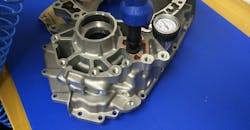In recent years the cost of casting impregnation has increased significantly. The chemicals that make up the sealant formulations have become more expensive, and the process also has become more complicated and expensive with the addition of recycling, filtration, and evaporation equipment, in the attempt to make porosity sealing a more environmentally acceptable process. The result is significantly higher operating costs, which is reflected in a much higher cost per part being impregnated.
The current process involves processing baskets of castings through a line of tanks and uses large volumes of sealant, water, inhibitors, and energy – all required to heat cure the sealant. VOCs are emitted into the atmosphere in the form of sealant-laden vapors from the heated curing process and from the vacuum pump exhaust. The process is neither economical nor environmentally friendly.
Is there another way? The current impregnation process has hardly changed since the 1970s – so it’s a good time to review investigate other ways to seal castings.
One alternative is to look at where the casting leaks to see if sealant can be applied directly to the area of porosity. Applying the sealant directly to the porosity using pressure or heat (“localized impregnation”) requires only a pressure gun or heat gun as opposed to a complete vacuum impregnation system, saving considerable capital investment, production floorspace, and running costs.
Furthermore, tailoring the sealant viscosity to the leak rate and size of the porosity is possible with localized impregnation methods. Just because the porosity is gross (for example >200 µm in diameter) doesn’t mean the casting has a structural defect and cannot be sealed; that is simply a restriction of the current process.
This is because the current vacuum impregnation process uses just one viscosity of sealant, typically 10-15 cps, whereas porosity can range in size from ultra-fine to gross. Having just one viscosity limits the recovery rate, as it cannot be both thin and thick at the same time.Locally applied sealants also do not require water washing and therefore do not incur the associated costs of chemical additions and trade effluent. Only a very small amount of sealant is used and the impregnation cost per part is typically just one-tenth of the cost of using a vacuum impregnation system.
A question that is often asked is, ‘How does a locally applied sealant penetrate into porosity without using vacuum?’ The answer is, in the same way that water, machine coolant, oil, and dye penetrant find their way into the porosity and have to be removed before effective impregnation can be completed. The requirement for pre-treatment to remove these contaminants before impregnation is detailed in OEM and military specifications. It is therefore acknowledged that these liquids enter the porosity during machining and testing through friction, heat, pressure, or by natural penetration.
Modern sealants have very low viscosities and surface tensions. Combined with pressure and/or heat they will readily penetrate into porosity. It’s worth remembering that vacuum/pressure impregnation plants were first designed in the 1960s to force phenolic and polyester resins into porosity, which were considerably thicker than modern day impregnation sealants.
Implementing localized impregnation
In Example A, an automotive engine manufacturer has recovered over 2,000 engine blocks using the Spot-Seal process, saving over £600,000 ($787,000) on the casting and machining value alone. The true savings are much greater when considering the recovery of otherwise lost production. Vacuum impregnation equipment could not be used due to the risk of contamination, corrosion, and damage to finished machined engine blocks.
In Example B, an automotive component supplier had an issue with cast aluminum housings displaying leaks through porosity on pressure test. Due to the complexity of the housings, the normal vacuum impregnation process was unsuitable. External testing of housings that had been sealed using localized impregnation passed all the required tests. To date, over 3,500 housings have been sealed, with a saving of over €840,000 ($928,000) using Spot-Seal localized impregnation.
Localized impregnation is a very fast and inexpensive method for impregnating porosity in metal castings. The equipment is simple, and a range of sealants are available to seal different sizes of porosity and leak rates from very fine to gross and even cracks.
Significant cost savings are achieved by reducing sealant usage by >90% and removing the need for water washing, hot water curing and all the associated chemical and energy costs, trade effluent and VOC emissions.
Localized ‘pressure’ impregnation uses a hand-held pressure gun to push the sealant into the porosity and is ideal for sealing porosity connected to machined holes and other drillings.
Localized ‘heat’ impregnation uses a hot air gun to heat an area of porosity followed by brush or spray application of the sealant and is ideal for sealing porosity connected to an as-cast surface.
Paul Young is the director of Impregnation Solutions Ltd. Visit www.impregnationsolutions.com for more information.
About the Author
Paul Young
Director
Paul Young is the Director of Impregnation Solutions Ltd., Solihull, England. Contact him at [email protected] - or visit www.impregnationsolutions.co.uk

